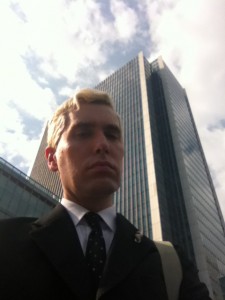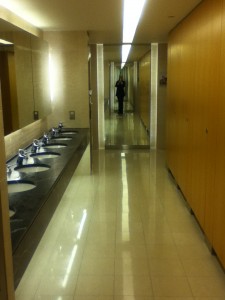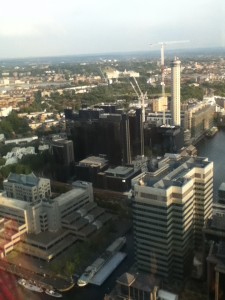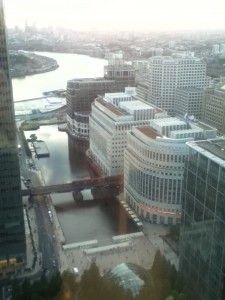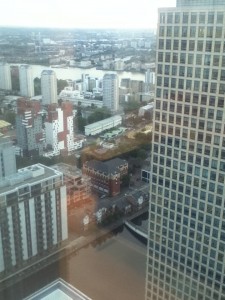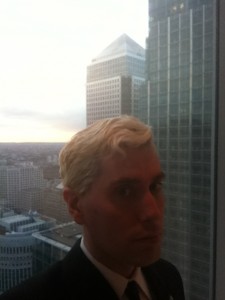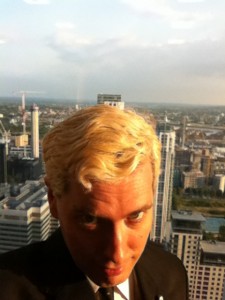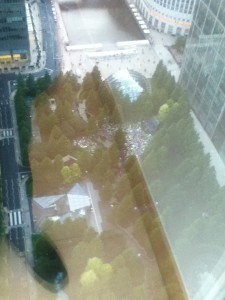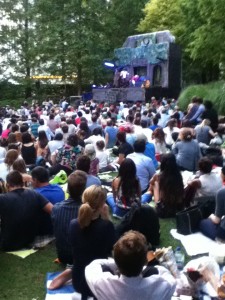Saturday 16th May 2015.
Still enjoying my freedom after finishing the degree, while trying not to spend money in doing so. I’m tidying up at home, filing notes in lever-arch folders, then putting the folders away in cupboards. I wonder if I still need to keep quite so many handouts on revising for exams, but keep hold of them anyway. For now. I also make a series of trips this week, to empty my locker in Gordon Square, getting rid of my old set texts.
My copy of Malcolm X’s Autobiography is now in the hands of a young barista, who works in a café on Bedford Way. While paying for my americano, I idly mention I am on my way to Oxfam, and indicate my bag of paperbacks. The barista asks if he could have first dibs. He is delighted to get Malcolm, though he turns his nose up at The Bell Jar.
* * *
Sunday 17th May 2015.
I visit somewhere in London I’d been meaning to go since reading Eastward Ho!, the Jacobean comedy. There’s a scene set at Cuckold’s Point in Rotherhithe, opposite the Isle of Dogs. In the play, Slitgut, a butcher’s apprentice, has to renew the pair of ox horns which sit on the top of a pole there, thus giving the Point its name. One story goes that King John was caught in flagrante with a miller’s wife, and hastily offered the husband the land to one side of the Point, by way of apology. Hence the cuckold’s horns. The tale seems fairly apocryphal, though as transactions over sex scandals go, it’s hardly the strangest.
I take the tube to Canada Water, then a C10 bus to Pageant Steps, the nearest stop to the Point. The wharf is now built-up and lined with a series of pretty, Toytown-esque modern flats in red and cream brickwork. A new stone obelisk marks a break in the estates, with no markings at all. A monument to clean architectural blankness, perhaps. The Thames Path here is a public walkway, though it’s annoyingly broken up by private sections every now and then. There’s a set of old wooden steps leading down to the beach. The tide’s in when I visit, so the water breaks against the steps noisily. I stand and look out over the wall. A sunny, quiet Sunday. Canary Wharf’s monied towers blink warily at me from the other side.
I doubt that the steps are the ones that appear in the eighteenth century painting by Samuel Scott, A Morning, With A View of Cuckold’s Point. But this is Cuckold’s Point all right. The noise of the waves would make it a good spot to record a radio play version of Eastward Ho!
I stop for a drink at the Blacksmiths Arms nearby, a pleasant South London family pub. Then on through the Hilton Docklands Riverside hotel, exploring its covered walkway across the old dry dock. Then I catch the shuttle boat to Canary Wharf (£2.50, ten minutes).
I’m here to see a new part of the Isle of Dogs development that’s just been opened: Crossrail Place. It’s not even on many of the local signs, or even on Google Maps, which still has it down as ‘North Dock’.
As the name suggests, Crossrail Place is built over what will eventually be the Crossrail station for Canary Wharf.  To get there, I walk through the Adams Plaza Bridge, a geometric covered walkway. The main attraction is a long roof garden, designed by Norman Foster, which has an even more futuristic feel than the bridge, albeit one imagined in 1970s films, such as Silent Running and Logan’s Run. There’s a hood-like tesselated roof, with some of its sections open to the air. The plants are chosen to represent the Docklands history of global imports: Japanese maples and magnolias, tea trees, gum trees, lots of ferns.
I visit the new Everyman Canary Wharf cinema, tucked away several floors below, deep inside this latest castle of Lord Foster. A blue-haired woman there recognises me from my sole visit to the Everyman Selfridges screen. That pop-up screen, she tells me, has now been transplanted to this one; scatter cushions and all. ‘It isn’t a pop-up this time. This is indefinite.’
I think about the meaning of Crossrail Place as a name. Something that’s definitely there, named after something that’s not there, not yet. The backwards chronology, of being named after something from the future.
Then I descend into the Canary Wharf underground shopping malls, looking for a way out. Overlit, nearly empty, most of the shops closed on this Sunday evening. I get lost. ‘Ground’, I realise, is not necessarily the ground: the promenade levels linked to the tube stations are underground, so they have minus numbers. When looking for the way out, minus is a plus.
On the third time of repeating my steps, I start to go a little crazy. I look at a shopping map and count up the franchises. The winner is Pret A Manger, with five branches. I have visions of a labyrinth of endless underground Prets, all closed, and me locked in with them. It triggers an existential panic. Pret A L’Etranger! No Exit!
Eventually, I find my way to one of the DLR stations, and take its ghost train up and round and out of there. It’s the words of the blue-haired girl that stay with me: ‘This is indefinite’.
* * *
Tuesday 19th May 2015.
Back to Birkbeck in Bloomsbury, for one of their free Arts Week events. The novelist Deborah Levy gives a talk, ostensibly for the MA Creative Writing students, but it’s opened up to the public. As a result, it’s been moved to one of the larger lecture halls in Torrington Square. Literary events do seem to be bigger than ever. (I wonder if I could give talks on diary writing?)
Ms Levy wears a black velvet dress and speaks beautifully and generously. Her writing covers more genres than I thought: fiction, poetry and scripts for animated films. She begins with a Ballard quote:
‘I believe in the power of the imagination to remake the world, to release the truth within us, to hold back the night, to transcend death, to charm motorways […] I believe in the beauty of all women, in the treachery of their imaginations, so close to my heart’.
The latter line, about the female imagination as treacherous, is Ms Levy’s favourite. (I prefer the bit about charming motorways).
She talks about the changes in writing technologies; how her first novel, Beautiful Mutants (1987) was written using a typewriter and carbon paper. Now she has a range of Macs. The internet has changed the focus on research: it makes us ‘amateur experts in anything’, she says. But she warns that ‘staring at a screen is not staring at the world’. The first line of Swimming Home was inspired by Rilke’s Letters to a Young Poet.
Ms L spent two years reading Freud ‘solidly’, and recommends everyone reads his case studies. Reading Freud for her was ‘like taking acid’.
* * *
Thursday 21st May 2015.
To the Barbican Screen One, for the new Mad Max film, Fury Road. I’m not at all keen on noisy action films, but the word of mouth on this one was intriguing. It’s the highly-wrought aesthetics and design that are its main appeal. They produce a fully realised world, with a very Australian feeling of a sun-scorched, marginalised take on the usual post-apocalyptic frolics (the Brisbane-born director, George Miller, also did the original Max Max films). It’s also reminiscent of the Duran Duran video for ‘Wild Boys’, of Heavy Metal the magazine, heavy metal the music (not least Iron Maiden album sleeves), and of the comic 2000AD in the 1980s, possibly because Brendan McCarthy (a veteran 2000AD writer) is involved. Despite this piling up of 80s influences, it overcomes any nostalgia by adding a very 2015 tone of pro-disabled & pro-feminist anger. Charlize Theron’s one-armed, crop-haired renegade carries the film’s main mission, while the male leads are either noble grunts who get drawn in (Tom Hardy’s Max) or white-skinned lost boys desperate for approval (Nicholas Hoult). I loved it for the same reason as I loved Mr Lurhmann’s Great Gatsby 3D: sheer, consummate design talent.
* * *
Friday 22nd May 2015.
Fashion blogger Danielle Bernstein is profiled in Harper’s Bazaar about the money she earns. She’s 22 and has a million followers on her Instagram account, ‘WeWoreWhat’. She commands ‘from $5,000 – to $15,000’ every time she posts a sponsored photo of some ensemble. Asked about her annual income, she says ‘it’s in the mid-six figures.’
While I wish Ms Bernstein well, it’s hard not to feel depressed how this reflects on my own situation. I’m technically a blogger of some 18 years experience now – most of Ms Bernstein’s lifetime. But I’ve so far failed to command even a minimum wage from it.
Still, I admit it’s not quite the same. I don’t really ‘blog’, I write a diary. I don’t do regular sponsored posts (though if a menswear firm wanted to sponsor me, I might make an exception). I don’t carry pop-up adverts, out of aesthetic choice. I also don’t do Instagram, being more of a wordsmith.
But the key difference is that she’s good at social media, and I feel relatively anti-social. The adage used to be that life was ‘not a popularity contest’, that the socially awkward kids, the quiet kids, the misfits, the bookish types, all had as much to offer as the popular kids, the jocks and the cheerleaders.
Today, social media has changed all that. It validates the cheerleader mentality as a lifelong ideal. Your value as a person is down to your amount of followers, rather than who they might be. The geek has not inherited the world: he’s just used the internet to become a new form of jock. The ‘core’ geeks – the quieter, the less financially driven, the weirder creative types, and anyone who doesn’t see mass popularity as an end – are in danger of being more marginalised than ever.
Still, I have also had some cheering news. A publisher wants to include some of my diary entries in a new anthology – a different one to A London Year. And this time they can afford to pay me. Not a life-changing amount. But it is the first time I’ve been paid in cash to contribute to a book. So I hope for more of that sort of thing.
It’s taken me most of my life to accept that I’ll never be among the cheerleaders. But I also know that I’m not as alone as I thought. And this is why I go on.
* * *
Tags: birkbeck, canary wharf, crossrail place, cuckold's point, deborah levy, writing


